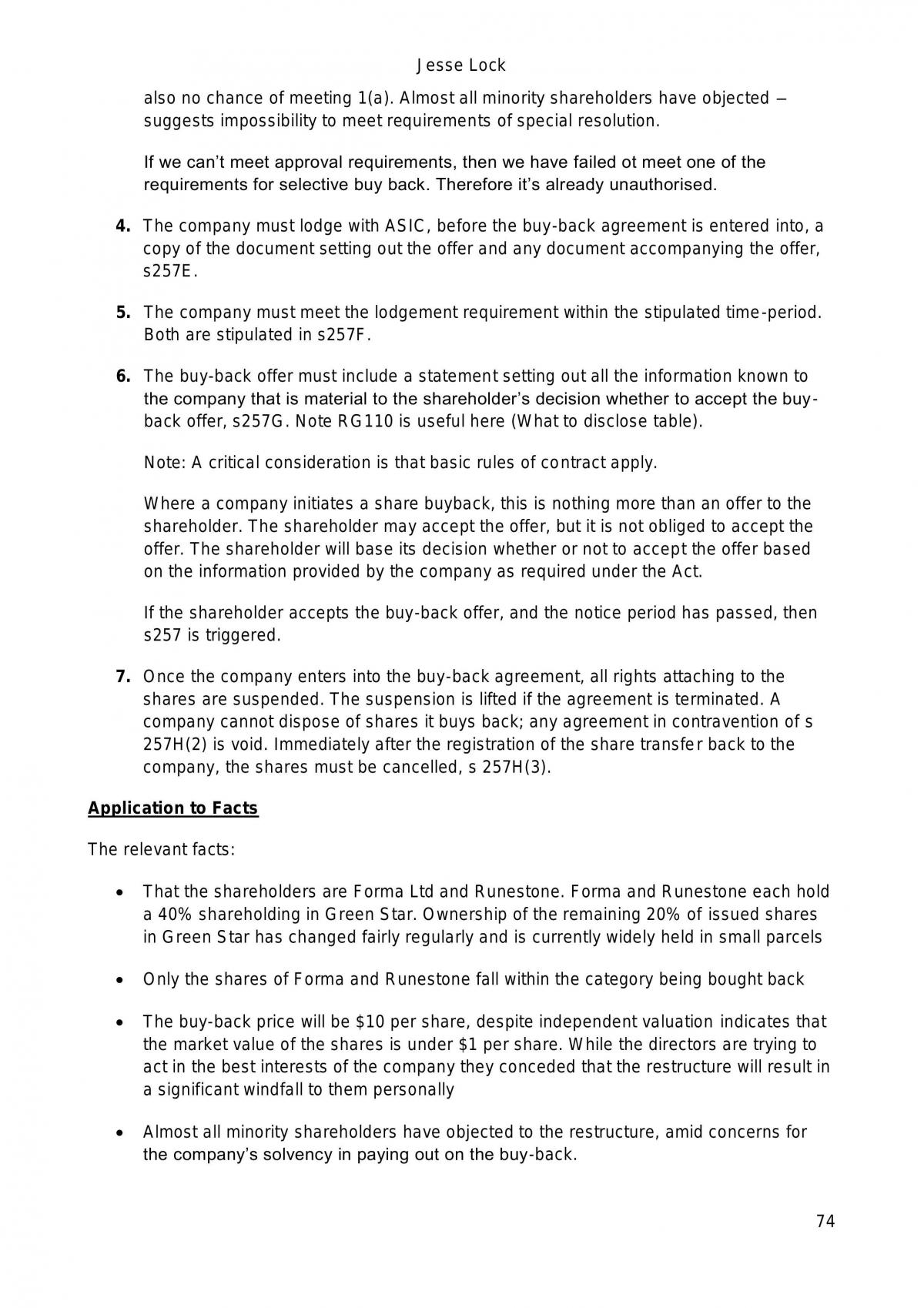Find
Search for over 200,000 study notes and past assignments!
Swap
Download study resources by swapping your own or buying Exchange Credits.
Study
Study from your library anywhere, anytime.
148 Pages • Complete Study Notes • Year: Pre-2021 • Previously uploaded under: LWB334 - Corporate Law
Incorporation Process 1. Characteristics of Incorporated Companies • The company is a separate legal entity in its own right (most attractive aspect): o an artificial person created by law o separate from its directors shareholders investors and employees o responsible for payment of its own debts o can own property in its own name o can sue and be sued in its own name • Also want to incorporate because it exists from registration until deregistered, tax advantages and are effective vehicles to conduct business. • Management of a company lies with persons vested with such power under its constitution, or where there is no constitution, the board of directors (under the replaceable rule in s 198A CA) except where a resolution is required by the members • Companies must have members, called shareholders if there is share capital • Companies may raise debt or equity 2. Requirement to Incorporate 2.1. Mandatory incorporation Where 20 or more persons wish to carry on a business for gain, there is a requirement to incorporate: s 115(1) Corporations Act The regulations specify higher numbers for professional partnerships in accordance with s 115(2) CA: r 2A.1.01 Corporations Regulations 2.2. Optional incorporation Advantages • company is a new and independent legal entity • limited liability for members/shareholders • indefinite existence & taxation advantages Disadvantages • Penalty provisions applying to defaulting directors (eg, Pt 9.4B Corporations Act) • Fees (eg, registration, filing ASIC returns, etc.) 3. How to Incorporate • Lodge an application s117(4) • Reserve the company name: ss152 and 601DA • Include information required by s117(2)(a)-(n) • Public companies include their constitution: s117(3) • Pay the registration fee • ASIC registers the company, issues the certificate of registration and ACN: s118(1) • The ACN allows company to fill out the legal documents in own name or ACN 4. Types of Registered Companies Section 112(1) Corporations Act classifies registered companies according to: • liability of members on winding up • public or private (proprietary) • listed or unlisted • relationships with other companies (holding and subsidiary companies) Members of a limited liability company are not personally liable for the company’s debts 4.1 Classification by Liability of Members on Winding Up Proprietary companies Limited by shares Unlimited with share capital Public companies Limited by shares Limited by guarantee Unlimited with share capital No liability 4.1.1 Company limited by shares Use Used almost exclusively for trading and the most prevalent form of company. Definition s 9: company formed on the principle of having the liability of its members limited to the amount (if any) unpaid on the shares respectively held by them. Creditors take on this risk when dealing with company (not paid + hide behind corporate veil). To circumvent this problem creditors may insist upon security for the debt or personal guarantees of the directors or occasionally the controlling shareholders of the company. Liability Subject to sections 518 and 519, a member need not contribute more than the amount (if any) unpaid on the shares: s 516 Corporations Act. Shareholders with fully paid shares have no further liability to the company or its creditors. Company responsible for payment of own debts – if the company doesn’t have enough money to pay debts – then it might get liquidated and creditors may be unpaid Note employees – s 556(1)(e)(i) – always paid out before creditors (insolvency law) Public or proprietary Can be public or proprietary Name A limited public company must have the word "Limited" at the end of its name unless section 150 or 151 applies. A limited proprietary company must have the words "Proprietary Limited" at the end of its name: s 148(2) Corporations Act. Ltd/Pty Ltd may be used instead: s149 4.1.2 Company limited by guarantee Use Has no share capital. Used for charities, professional organisations, education, etc. The profits go to the objects and purposes of the company, rather than the members (eg, RACQ). Definition s 9 Cs Act defines as a company formed on principle of having the liability of its members limited to the respective amou1nts that the members undertake to contribute to the property of the company if it is wound up. Always a nominal amount ($2). Liability Subject to sections 518 and 519, member need not contribute more than the amount undertaken to contribute to the company's property if the company is wound up: s 517 Public companies limited by guarantee that fit the description of a small company in s 45B have reduced financial reporting requirements. Unless directed by a member (s 294A) or ASIC (s 294B), a small company does not have to: prepare a financial report or have it audited; prepare a directors’ report, or notify members of annual reports (ss 292 and 296). Public or proprietary Must be public only Name A limited public company must have the word "Limited" at the end of its name unless section 150 or 151 applies: s 148(2) Corporations Act Ltd may be used instead: s 149 Corporations Act
This document is 25 Exchange Credits
More about this document:
|
|
This document has been hand checkedEvery document on Thinkswap has been carefully hand checked to make sure it's correctly described and categorised. No more browsing through piles of irrelevant study resources. |
|
|
This is a Complete Set of Study NotesComplete Study Notes typically cover at least half a semester’s content or several topics in greater depth. They are typically greater than 20 pages in length and go into more detail when covering topics. |
|
|
What are Exchange Credits?Exchange Credits represent the worth of each document on Thinkswap. In exchange for uploading documents you will receive Exchange Credits. These credits can then be used to download other documents for free. |
|
|
Satisfaction GuaranteeWe want you to be satisfied with your learning, that’s why all documents on Thinkswap are covered by our Satisfaction Guarantee. If a document is not of an acceptable quality or the document was incorrectly described or categorised, we will provide a full refund of Exchange Credits so that you can get another document. For more information please read Thinkswap's Satisfaction Guarantee. |

Studying with Academic Integrity
Studying from past student work is an amazing way to learn and research, however you must always act with academic integrity.
This document is the prior work of another student. Thinkswap has partnered with Turnitin to ensure students cannot copy directly from our resources. Understand how to responsibly use this work by visiting ‘Using Thinkswap resources correctly’.
Browse QUT Subjects




